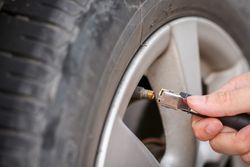Why You Have Tire Pressure Problems in the Winter

Low tire pressure is a common problem for drivers in the winter. As the temperatures drop, so does your tire’s PSI (pound per square inch of pressure). Unfortunately, water, ice, and other poor driving conditions place more of a strain on your tires. Know what causes this issue and how you can keep your tires in safe driving condition all season long.
A Guide to Low Tire Pressure in Winter
Why It Happens
Temperature changes the way that air molecules move. They move more quickly in warm temperatures, and slowly in cold temperatures. When they move slowly, the air takes up less space and reduces your tire pressure.
 You may see that your tires look low, or your TPMS (tire pressure monitoring system) may indicate that your pressure is low. This doesn’t mean you have a leak, but it does mean that the air has condensed. The cold temperatures at night and in the early morning cause the pressure to be lowest when you first get in your car each morning. As you drive, the tires warm up, and the air expands.
You may see that your tires look low, or your TPMS (tire pressure monitoring system) may indicate that your pressure is low. This doesn’t mean you have a leak, but it does mean that the air has condensed. The cold temperatures at night and in the early morning cause the pressure to be lowest when you first get in your car each morning. As you drive, the tires warm up, and the air expands.
What to Do
Tire pressure decreases around 1 PSI for every 10 degrees that the temperature drops. You should check your pressure at least once a month during the winter and top off your air as needed. Read the pressure in the morning when the tires are cold, as this will give you the most accurate reading. If you get a low-pressure warning or your tire looks visibly low, check it immediately and add air.
If your tire tread is wearing low, now is the time to replace them. The mechanics at H & S Tire & Auto Center have a combined 70 years of experience with car maintenance and repair in Wentzville, MO. They work with all vehicle makes and models, and carry a wide selection of tires so you can find a set that suits your needs. Learn more on their website and call (636) 327-5225 to schedule a free estimate.
About the Business
(165 reviews)
Have a question? Ask the experts!
Send your question

